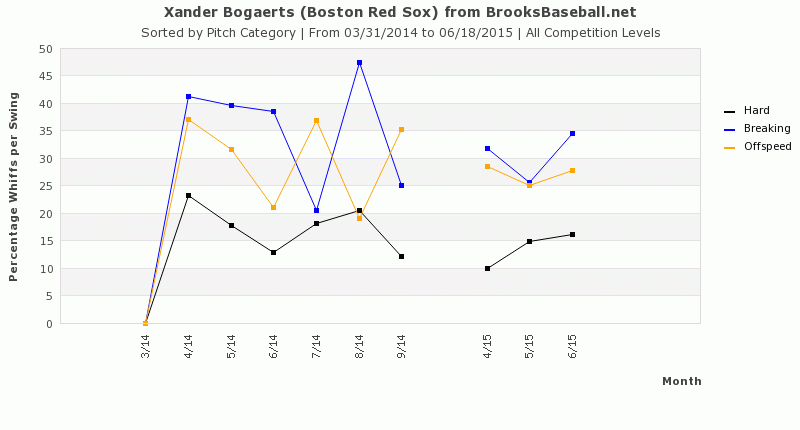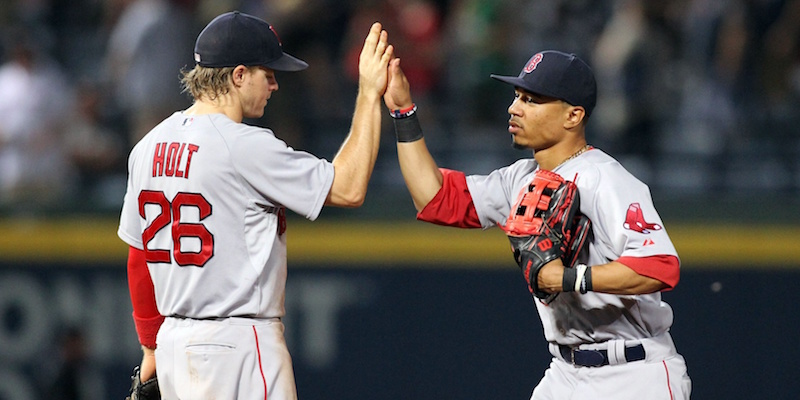Two wins in three days. Whew. Feels good, different.
Top Play (WPA): Despite the loss, the Braves won the less important race for top play by WPA. In the sixth inning, with the bases loaded and two outs, A.J. Pierzynski grounded a Clay Buchholz pitch weakly toward first. Buchholz did everything right, initially; he got to the ball quickly, waved David Ortiz back to cover first, but then, when it came time to finish the deal, he glove-flipped the ball over Ortiz’s head, perhaps forgetting who was lumbering down the line. Two runs scored on the play for the Braves (+.141).
Brock Holt’s leadoff fourth inning triple (+.129) was the no. 2 play by WPA, which gives me a moment to discuss Boston’s unheralded star. Holt has a .314 TAv this season (through Wednesday’s games), a figure super-utility god Ben Zobrist has only reached once in his career. It probably won’t continue, as Holt’s performing somewhere north of his 90 percentile PECOTA projection, but it sure is fun while it lasts. Even if Holt’s offense dips back to reality, his positional flexibility makes him a valuable player.
Bottom Play (WPA): In the fourth inning, Nick Markakis weakly grounded a ball to shortstop, which Xander Bogaerts easily turned into an unassisted double play (-.101).
Key Moment: The bottom of the first inning. Jace Peterson took a first-pitch 90 mile-per-hour cutter — Buchholz’s first pitch of the night, no less — and roped it down the right field line for a leadoff double. Oh boy.
Then Buchholz, as a good pitcher should, settled down and got out of the first unscathed. Buchholz got Cameron Maybin to ground out to third, he struck out Nick Markakis with a high change, then he got Juan Uribe to fly out weakly to center.
After the first Buchholz toggled on efficiency mode, mowing down a weak Braves lineup — Uribe batting cleanup, Pierzynski batting fifth — while preserving his pitch count. Buchholz threw just 10 pitches in the second inning, seven in the third, nine in the fourth, and 12 in the fifth before finally laboring through the sixth inning, where an error of his own led directly to Atlanta’s only runs of the night. Buchholz finished off the sixth and battled through the seventh without surrendering further damage, finally giving way to the bullpen in the eighth.
The line: 7 innings, 6 hits, 2 runs, 1 walk, 3 strikeouts, 92 pitches (63 strikes)
Trend to Watch: The continued development of Xander Bogaerts, on both sides of the ball, has been an unwavering bright spot so far in 2015. Bogaerts, who struggled through a disappointing 2014 campaign with a .247 TAv and -10 UZR, has rebounded in 2015 with a .273 TAv and an unforeseen defensive turnaround at shortstop.
The offensive catalyst for Bogaerts’ resurgent bat has been his ability to make contact (along with his willingness to go the other way), as he’s cut his strikeout rate from 23.2 percent to 14.4 percent, a number he hasn’t touched since he was a 17-year-old in the Dominican Summer League. Check out the following graph from Brooks Baseball, which tracks Bogaerts’ whiff percentage on hard, breaking, and offspeed pitches since the start of 2014:
 It’s not a dramatic improvement, but Bogaerts has made better contact with every pitch type so far in 2015, and it’s helped significantly raise his batting average and ability to get on base.
It’s not a dramatic improvement, but Bogaerts has made better contact with every pitch type so far in 2015, and it’s helped significantly raise his batting average and ability to get on base.
Bogaerts has perhaps made even greater strides on defense, where he’s suddenly morphed into an above average shortstop. Last season he looked out of place defensively at shortstop and third base, struggling both with routine and difficult plays, lapses in concentration, and range that didn’t appear cut out for baseball’s most demanding (non-catcher) position. This year the Red Sox challenged Bogaerts, putting together a groundball-heavy staff and sticking him back at short, and so far he’s responded. Bogaerts has been a sure thing on routine grounders while showing better range and instincts at short. Consider Bogaerts’ Inside Edge fielding data from FanGraphs (his rank among qualified major-league shortstops is in parenthesis):
| Unlikely (10-40%) | Even (40-60%) | Likely (60-90%) | Routine (90-100%) |
| 14.3 (21/27) | 60 (8/27) | 94.7 (2/27) | 98.8 (4/27) |
We’re still working with some really small sample sizes in some of those buckets, but take a look at the last two, the ones where shortstops get the most chances. Bogaerts is second behind only Jimmy Rollins in ‘Likely’ plays and fourth behind Andrelton Simmons, Jose Iglesias, and Jhonny Peralta in ‘Routine’ plays. He’s traded in a shaky glove for a steady one, and even if Boston’s 2015 season continues to tailspin out of control, Bogaerts’ development is something we can cling to.
Coming Next: The Red Sox travel to Kansas City to take on the first-place Royals for a three-game series starting Friday, where Eduardo Rodriguez faces Yohan Pino in the opener. The defending American League Champion Royals not only lead the AL Central at 38-25, they also have the second-best third-order winning percentage (.596) in the AL, behind only the Astros. They’ve been led by an all-star offense that features five regulars with .280-plus TAvs — Alex Gordon (.310), Mike Moustakas (.309), Eric Hosmer (.296), Lorenzo Cain (.295), and Kendrys Morales (.285).
Photo by Brett Davis/USA Today Sports Images
